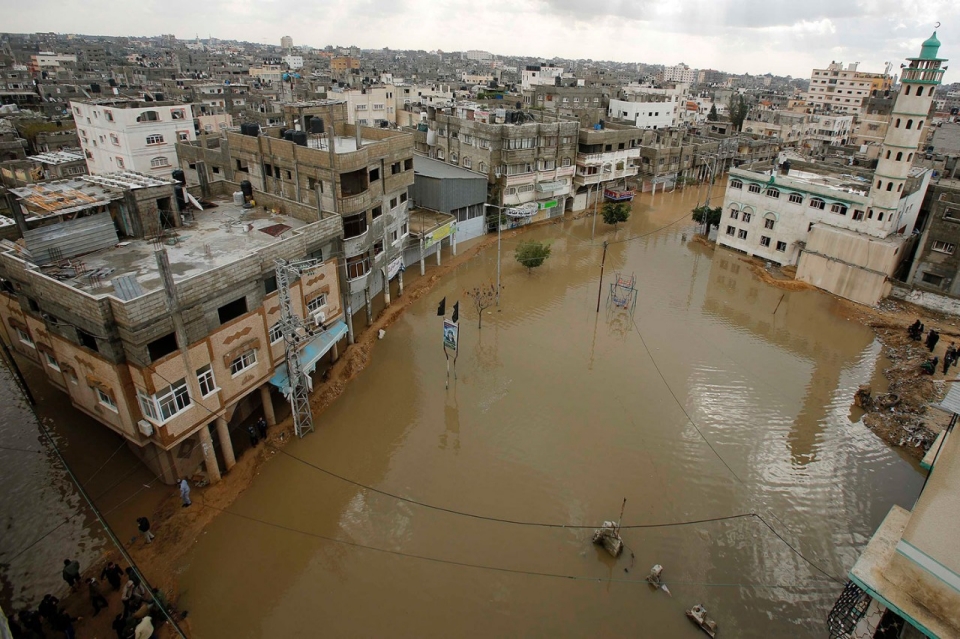Originally published on Ma’an News Agency on Dec. 13, 2013.
BETHLEHEM (Ma’an) — The Gaza Strip was pounded by fierce winds and rain again on Friday as flooding reached dangerous levels in many areas, forcing thousands to flee their homes amid widespread power outages as temperatures plunged into the single digits.
The flooding was worst in the northern Gaza Strip, where hundreds fled their homes and water levels reached 40-50 cm in some parts, forcing residents to use boats to navigate their neighborhoods.
The Gaza government said in a statement on Friday that so far 2,825 people have been evacuated from their homes, reaching a total of 458 families.
The evacuated were being sheltered in schools across the Strip, the statement was reported by Gaza-based Safa News Agency as saying, as Hamas civil defense authorities rushed to evacuate flooded homes.
Gaza Minister of Health Mufid al-Mukhalalati declared a state of “extreme emergency” as all emergency devices and ambulance crews were put on a state of high alter in all regions of the Gaza Strip.
Meanwhile, the minister of Local Government Muhammad Farra instructed the mayors of Gaza to suspend all leave for staff and workers in the water and sanitation sectors until the end of the current crisis.
Farra said in a press statement that municipal crews “will work day and night” until the storm passes, stressing that they will continue their efforts despite the lack of fuel and electricity.

UNRWA spokesperson Chris Gunness told Ma’an, “In Gaza there is a significant problem with flooding in the north, specifically in Jabaliya, and UNRWA staff has been working all night.”
“An UNRWA staff member reported that there were three meters of water surrounding his house,” he added, pointing out that water had come up to the first floor in some areas.
UNRWA was engaged in emergency evacuations “around the clock” as heavy rains flooded many neighborhoods across the densely populated coastal enclave, he added.
“After so many years of the Israeli blockade, the public health system in Gaza was already acutely and chronically damaged, so the man-made problems inflicted on Gaza are compounded by the extreme weather conditions.”
On Thursday, the Gaza Disaster Response Committee announced it was working “around the clock” to help those affected. The high water levels also shut down the Erez, or Beit Hanoun, crossing, a Palestinian military source told Ma’an.
He said that access to the crossing had been completely cut due to flooding from the storm, adding that a number of vehicles transporting sick patients to pass through the crossing had gotten stuck in the water. Despite this, the crossing would stay partially open on Friday for those needing medical attention as well as some travelers.
Ezz al Zanoon, a photographer based in central Gaza, described to Ma’an how the flooding was affecting daily life in the Strip.
“A friend of mine went out to get milk for his four kids and he had to go in a boat,” because of the flooding, he said, adding that boats were the easiest way for many to leave their houses.
“In many areas water has flooded the houses, the entire first floors are flooded. In Sheikh Redwan it’s the worst, but also in Jabaliya and Khan Younes.”
“The civil forces are trying to help (clear the flooding), but there’s no solution.
They need electricity to help move the water.””I don’t know how people are living,” he added.
Zanoon stressed that the storm had compounded the already dangerous conditions Gaza residents were living under as a result of severe fuel shortages over the last few months.
“Electricity is only on for one or two hours a day,” he said, pointing out that in the days before the storm’s arrival daily electricity availability had dropped drastically from previous levels of six to 12 hours.
“People are suffering as they wait up all night for the electricity and water to come on,” he added, pointing out that water availability was dependent on the availability of electricity with which to pump it.”There is no movement, no one goes out. Even those who work can’t go out.”
“How could they let the situation of the children in this country become like this?”
“We know there is a siege (on Gaza), but there has to be a solution. Abbas is the most responsible, why doesn’t he do anything?”
Fuel shortages have caused daily life in the Gaza Strip to grind slowly to a halt since early November, as power plants and water pumps are forced to shut down, cutting off access to basic necessities for Gaza residents.
The Gaza Strip has been without a functioning power plant since the beginning of the month, when the plant ran out of diesel fuel as a result of the tightening of a seven-year-long blockade imposed on the territory by Israel with Egyptian support.
The plant itself was only reopened last year after it was targeted by an Israeli airstrike in the 2006 assault on the Strip. The power plant generates around 30 percent of the Gaza Strip’s electricity supply, while the rest comes from Israel and Egypt.
Until July of this year, the tunnels to Egypt provided a vital lifeline for the territory amidst the otherwise crippling Israeli blockade. The blockade has been in place since 2006, and it has limited imports and exports and led to a major economic decline and wide-reaching humanitarian crisis.
In the last year, however, the situation had greatly improved, as the tunnels to Egypt witnessed a brisk trade following the Egyptian Revolution.
Gaza Strip energy officials have blamed Egypt for destroying numerous tunnels linking the Gaza Strip and Egypt in recent months. They also blamed the Fatah-led Palestinian Authority for charging taxes on fuel too high for Gaza Strip authorities to afford.